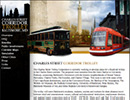Baltimore’s Charles Street is one of the oldest thoroughfares in North America. Traditionally, it has been the road that divides the Eastern and Western sections of Baltimore City. Because of this geography, Charles Street became an important residential and retail center at an early stage in the city’s history. Now stretching from South Baltimore to the northernmost curve of the Beltway that surrounds the city, Charles has become a crucial artery for connecting the historic and cultural attractions of urban Baltimore with the suburbs at the north end of the city and beyond.
After the City was incorporated in 1796, Downtown Baltimore became the site of much of Baltimore’s early history. Unfortunately, much of the area was destroyed during the Great Baltimore Fire of 1904, which caused approximately $150 million in damages.
When Baltimore’s Inner Harbor was redeveloped by Jim Rouse in the late 1970’s, Downtown began to shift from being one the nation’s major seaports to becoming a business and cultural center. Now the area is the City’s largest tourist attraction, drawing millions of visitors annually.
Charles Street is well known for its late nineteenth and early twentieth century architecture, which is highlighted by churches and cathedrals that include the first Anglican and Unitarian churches in Baltimore as well as the nation’s first Catholic church, The Basilica of the Assumption. The Basilica was designed by internationally renowned architect Benjamin Henry Latrobe in the neo-classical style, similar to his design of the Capitol Building in Washington, D.C.
In the Mount Vernon neighborhood, just two blocks north of The Basilica, the original Washington Monument stands an imposing 190 feet tall at the center of a cobblestone section of the street. The monument was built on land given to the City by Colonel John Eager Howard and is flanked on all sides by Mount Vernon Place and its four famous parks, which were modeled after the residential squares of London during the Georgian period. Designed and completed by Robert Mills in 1829, the Washington Monument has been a source of pride for Baltimoreans and a popular destination for tourists ever since.
Mount Vernon was once home to many of the area’s wealthiest families and, consequently, the neighborhood holds many of Baltimore’s grandest and most opulent examples of 19th century architecture. Mount Vernon is the cultural heart of the city, with highlights that include the widely celebrated Walters Art Museum and the Peabody Conservatory, one of the finest conservatories of music in the world.
Just north of Mount Vernon is the Charles North neighborhood, which grew in the 1880s and 1890s as a suburb to downtown Baltimore when North Avenue delineated the northern boundary of the City. North Avenue’s wide boulevard-style sidewalks made the street an ideal commercial district, full of fine shopping and entertainment housed in landmark buildings that include the North Avenue Market and the Parkway Theatre.
Charles North suffered a decline in population over the years as many urban families moved out to the suburbs. In the past decade however, Charles North has made great strides toward growth and revitalization. The transit-oriented neighborhood surrounding Amtrak’s Penn Station is now part of the Station North Arts & Entertainment District and the center of an emerging local arts scene, which has fostered a popular retail district for small theaters, galleries, and restaurants.
To the north of Charles North lies the Old Goucher neighborhood. Old Goucher is home to many landmarks including the former campus of Goucher College, the Romanesque Lovely Lane Methodist Church, and several buildings designed by nationally recognized architect Stanford White.
Located farther north in the Charles Village neighborhood are the prestigious Johns Hopkins University’s Homewood Campus, the Homewood House and Evergreen House Museums, and the Baltimore Museum of Art.
